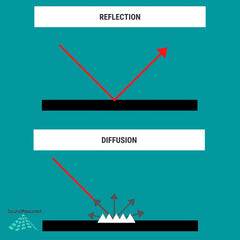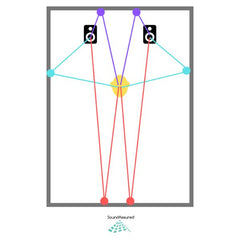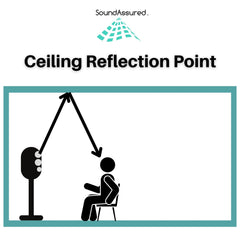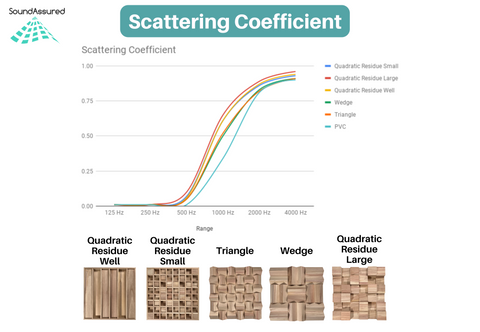How Do Acoustic Diffusers Work?
Share
Acoustic diffusers are devices designed to scatter sound waves in different directions to reduce echoes and control the acoustics in a room. They play a critical role in creating a more balanced and pleasant acoustic environment in spaces like recording studios, concert halls, home theaters, offices, and more.
Reflection vs. Diffusion
In a room, sound waves can either be absorbed, reflected, or diffused. Reflection occurs when sound waves bounce off a flat and hard surface, creating noticeable echoes and increasing reverberation. Diffusion, on the other hand, scatters sound waves in multiple directions, breaking up the direct path of sound and reducing reflections.

How Are Sound Waves Scattered?
Acoustic diffusers are typically designed with a specific irregular patterns, such as varying depths, heights, or shapes. These irregularities scatter sound waves by sending the sound wave in different directions.
The scattering of sound waves eliminated first reflection echoes. This is helpful when treating rooms with noticeable echoes which cause bad sound clarity.
The scattering of sound helps keep more liveliness in a room while treating for echo problems. On the other hand, acoustic absorption gets rid of echoes but does not keep as much sound energy inside the room. Many times a combination of diffusion and absorption is needed.
What Frequencies Work With Diffusers?
Acoustic diffusers can be engineered to work over specific frequency ranges. Some diffusers are effective at scattering sound across a wide range of frequencies, while others are designed to target specific frequencies.
The design and size of the diffusers determine their effectiveness. Low end sound waves are physically longer than high frequency sound waves. Therefore, low end waves require deeper well depths and more drastic design elements to effectively be diffused.
Since low end sound waves are harder to diffuse many people choose to use bass trapping to treat the low end and diffuse mid range and higher frequencies.
To effectively diffuse sound waves below 100Hz, you would generally need diffusers with deeper wells. The specific well depth required will depend on the target frequency range, the room's dimensions, and the intended use of the diffusers.
A well depth of around 4-6 inches (9-15 cm) is often considered suitable for addressing mid to high-frequency reflections. However, for low-frequency diffusion, especially for frequencies below 100Hz, deeper well depths of 12 inches (30 cm) or more will be necessary.
Our wood diffusers are designed to scatter high frequencies in your room.
Positioning and Design
Proper placement of acoustic diffusers is crucial for their effectiveness. They are typically positioned on walls or ceilings where sound reflections are a concern. The design and positioning of diffusers should be carefully considered to address the specific acoustic issues in a room.
There are various types of diffuser designs, such as quadratic residue diffusers, skyline diffusers, and binary amplitude diffusers, each with its own scattering characteristics.
In general, diffusers are placed at the reflection points in a room. This advice is more geared towards recording studios. For spaces like offices and classrooms you are better to spread the diffusion evenly throughout the room and the walls and ceilings.
To find the reflection points in your room draw imaginary lines between the sound source, the receiver, and the room surfaces. The goal is to find the paths that sound waves take when they travel from the source to the listener. Remember that the angle of incidence equal to the angle of reflection.
The drawing below shows imaginary lines drawn in a small room with two monitors.

The purple line shows your first reflection point on your front wall. These spots are generally directly behind your monitors.
The red line shows the first reflections on your back wall. These reflections are simply where your speakers are pointing towards.
The teal line shows side wall reflections. These are probably the hardest to find but there is a trick.
TRICK: The side wall reflection points can be found using the mirror trick! All you need is a small mirror. Sit in the listening position and have a friend move the mirror around on the side wall while you look into the mirror. When you can see your monitors in the mirror, that is a first reflection point!
We covered the walls, but there is still another major first reflection point to worry about, the ceiling!

For the most part the ceiling reflection point is between the monitors and where you are sitting, so essentially above your studio desk.
How Much Diffusion Is Needed?
Larger rooms with longer sound reflection paths will require different diffusers compared to smaller spaces. Below are some general recommendations. Keep in mind that these recommendations are for coverage with diffusion and absorption.
Recording Studios and Control Rooms:
50-70% coverage.
Focus on reducing reflections and flutter echoes.
Home Theaters:
30-50% coverage.
Aim for a balanced sound and reduced reverberation.
Conference Rooms:
20-30% coverage.
Maintain clarity while reducing excessive echo.
Classrooms and Auditoriums:
10-20% coverage.
Ensure good speech intelligibility.
Open Office Spaces:
5-15% coverage.
Strike a balance between speech privacy and collaboration.
Restaurants and Cafes:
10-20% coverage.
Enhance comfort without making the space too dead.
Diffuser And Absorber Recommendations
Sound Diffusion Materials
- Wood diffuser panels
- PVC diffusion panels
- Uneven surfaces like bookshelves also work well at sound diffusion.
Sound Absorption Materials
There are many materials that are effective at absorbing sound, including:
- Acoustic foam: specially designed foam that is made of open-cell polyurethane foam or melamine foam, which is excellent at absorbing sound waves.
- Fiberglass insulation: fiberglass batts like Owens Corning 703 are a popular choice for DIY acoustic panels.
- Acoustic ceiling tiles
- Fabric panels: these panels use acoustically transparent fabric on the surface and a core of rockwool or fiberglass insulation to absorb sound. These are popular DIY panels.
- Felt polyester panels - these panels are made of recycled polyester and are great for absorbing high frequencies and eliminating echoes.
- Natural materials: certain natural materials such as cork and cotton can also be effective at absorbing sound.









